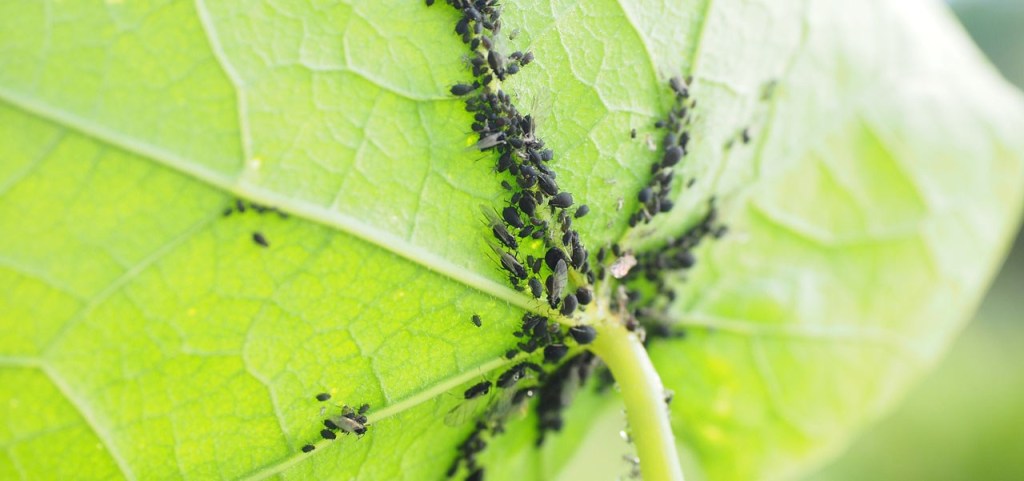Written by Jennifer Noonan and published on https://www.bobvila.com/.
If there’s one class of insect that bothers gardeners more than any other, it has to be aphids. These tiny pests can be found worldwide and they are to plants what mosquitoes are to people – small but destructive vampires. Aphids feed on the sap of plants, which is damaging enough on its own, but to get to the sap they chew up the leaves with their efficient jaws. They also breed rapidly and won’t stop feeding until they kill the plant, at which point they migrate to the next plant and the cycle starts all over again. To a biologist aphids are actually fascinating – some species of ants farm them, for example – but to gardeners they’re a serious pest.
Table of Contents
How To: Get Rid of Aphids
Save a shriveling garden from aphid infestation by following these tips for removal.
Are your garden plants stunted, shriveled, yellowing, or curling at the leaves, despite your best efforts to keep them alive? Check the undersides of the leaves, and you may find the culprit: large groups of aphids and/or the sticky residue they leave behind after feeding. (Or, on plants with tightly-packed leaves like those of day lilies, aphids may take root at the base of the plant instead.) These quarter-inch-long garden pests have soft pear-shaped bodies in various shades of white, black, yellow, green, brown, or red. The bane of gardeners everywhere, they feed on the plant’s sap and literally suck the life out of leaves, stems, buds, flowers, fruit, and roots.
Aphids reproduce so quickly—we’re talking several generations created in a single season—that by the time you notice the insects on your plants, you’re likely in the midst of a full-blown infestation. Thankfully, though, homeowners can often combat the pests before major damage occurs. Here’s how to get rid of aphids and keep them from returning to wreck your plants in the future.
STEP 1: Removal
If you discover aphids your garden, follow one of these three methods to get rid of them.
Hose them down.
If you spot a few aphids on your plants, the minor infestation can be successfully banished with a strong stream of water from the hose. Run water all over the plant, making sure to target the underside of each leaf. Repeat this process every few days until you’ve successfully eliminated all aphids, which could take up to two weeks.
Spray leaves with DIY insecticidal soap.
Waging war with larger numbers of aphids? Make a homemade insecticidal soap, a low-toxicity bug control solution that will desiccate the soft bodies and kill the aphids without doing harm to your plants. Simply mix a few teaspoons of liquid dish soap with one quart of water, then spray or wipe the solution onto the leaves, stems, and buds of the plant. (Don’t forget: These bugs like to hide beneath leaves, so take care to thoroughly coat the underside of the leaves, too.) Repeat the process every two or three days for the next few weeks, until you no longer notice aphids on the plant.
Use a systemic pesticide.
If your aphid infestation is substantial and not swayed by insecticidal soap, you may need to kill them with a systemic pesticide. Consider using a product containing Imidacloprid, which will kill aphids when ingested but won’t harm pollinators like bees, hummingbirds, and butterflies (view example Imidacloprid-containing insecticide on Amazon). Mix and apply according to the manufacturer’s directions.

STEP 2: Prevention
After eradicating aphids from your garden, take measures to prevent the pests from returning. Here are three ways to deter aphids from your plants.
Introduce beneficial bugs.
Several species of bugs—like lady beetles, lacewings, and parasitic wasps—happily munch on aphids. If you provide a habitat of flowering ground covers (especially varieties likecosmos and stonecrop that supply nectar throughout the growing season), you’ll draw them to the garden and successfully keep the aphid population in check. Homeowners can also purchase these natural predators via mail-order. If you introduce beneficial bugs to your garden, do not use a broad-spectrum pesticide—it will kill them, too!
Apply dormant oil.
If aphids have settled on your fruit trees, apply dormant oil (a commercial oil that controls pests during the off-season) in mid- to late-winter to kill any eggs that are overwintering (view dormant oil on Amazon). Mix the dormant oil with water in a garden sprayer, according to the directions on the packaging, and apply to the leaves, stems, branches, and trunk of the tree. Reapply per the manufacturer’s directions.
Choose neighboring plants strategically.
Oregano, chive, sage, garlic, leeks, onions, and other plants with strong scents can deter aphids. Plant these in the areas of your garden where aphids have been a problem. In addition, you can grow plants that attract aphids, like calendula and nasturtium, on the opposite side of your property; they may draw aphids away from the affected area. Companion planting is a long-term prevention measure, but it could help your aphid population diminish significantly over several seasons.
Original post https://www.bobvila.com/articles/how-to-get-rid-of-aphids/.

